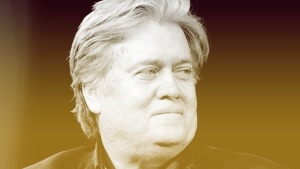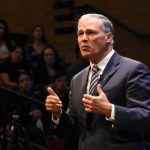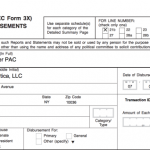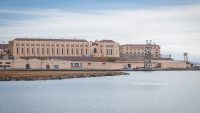Steve Bannon May Be A Bigger Asset To Trump Outside The White House Than In It
Steve Bannon has never been subtle about his desire to destroy the U.S. government.
In 2016, Bannon described himself as a Leninist. When a Daily Beast reporter asked what that meant, Bannon replied: “Lenin wanted to destroy the state, and that’s my goal too. I want to bring everything crashing down, and destroy all of today’s establishment.”
That was Bannon’s goal before he became a federal employee, funded by U.S. tax dollars. But Bannon’s views did not change when he became Trump’s chief strategist. In his February speech to CPAC, Bannon said his objective was to “deconstruct the administrative state” and that many of the injurious incompetents who fill Trump’s cabinet–the EPA head who opposes environmental protections, the HUD secretary who opposes public housing–“were selected for a reason, and that is deconstruction.”
Bannon sought to destroy the United States as we know it from both from within the White House as Trump’s advisor, and from outside it, back when he was the editor of white supremacist outlet Breitbart. Bannon sought to build a movement, not serve our government. In many ways, he succeeded: His white nationalist views became sanctioned at the executive level, and the U.S. government is chaotic, understaffed, and weaker on the global stage than at any point this century.
What is essential to realize is that, despite reports of a feud, Trump shares much of Bannon’s dark outlook. Trump spent his business career eagerly anticipating both social and economic disasters. “I sort of hope that happens because then people like me would go in and buy,” Trump said of the housing crash in 2006. Before that, Trump spent decades exploiting the damaged economies of towns like Gary, Indiana and Atlantic City, leaving them as bad or worse off than when he arrived. In 2014, Trump openly longed for the U.S. to “go to total hell” and cited riots as necessary for true American greatness–words that should worry all of us as we head into this tense weekend. Over the past two years, Trump has rarely condemned his white supremacist supporters who attack ethnic and religious minorities; at one point, he offered to pay legal fees for violent fans.
Trump declared “I alone can fix it,” but in order for him to fix it–that is, to consolidate his power under the guise of improving our nation–America needed to be broken, over and over again.
By the time Trump launched his campaign in June 2015, the U.S.–reeling from two wars, a long recession, and civil unrest–was vulnerable and looking for big change in any form: perfect prey for Trump’s vulture-like proclivities. By the time Bannon officially joined Trump’s team in August 2016, Trump’s run had radically shifted political norms and spurred a wave of hate crimes. Bannon was a natural fit: while Trump’s goals seem largely kleptocratic (abusing executive power to line the family coffers is an ongoing issue), Bannon’s destructive and racist ideology melded easily with Trump’s own views and that of his base, many of whom were readers of Breitbart.
Now it appears Bannon will return to Breitbart, but don’t think for one second that this is the result of some ideological rift between him and the president. There is no evidence that Trump–who on Tuesday equated neo-Nazis and Klansmen with those who protested them in Charlottesville–was suddenly so full of moral indignation that he fired Bannon, whose racist policies were blatantly promulgated in the White House for over six months and who Trump praised this week.
Instead, the two may very well be working, as they have for a year, in tandem.
First, the White House remains the White Supremacist House: neo-Nazi sympathizers Stephen Miller and Seb Gorka are still employed alongside civil rights antagonist Jeff Sessions and, of course, Trump himself. The Trump administration’s policies–anti-black, anti-Muslim, and anti-voter rights–remain unchanged. Stop the presses when Trump throws them all out.
Second, Bannon seems to have choreographed his departure in a way that benefits the broader white supremacist movement he and Trump support. In an interview with the liberal American Prospect–an interview which Bannon, a media professional, unconvincingly claimed he was unaware was recorded–Bannon sold himself as an “economic nationalist” and an opponent of “identity politics.” This move seems aimed at recasting himself as a more moderate, anti-Democrat populist in order to expand his own base and Trump’s, at a time when both are being scrutinized for their Nazi ties and bigoted views.
Third, Bannon may be just as useful for Trump outside the White House as he was within it–perhaps more so. Trump has, in the past, benefited from staff who depart and go on to work as TV propagandists and political backers on Trump’s behalf. Bannon may well serve a similar role while furthering his own ideological goals. Bannon presumably leaves with inside knowledge about the government and White House personnel, which he could use to target staffers he allegedly dislikes–like John Kelly and James Mattis–unencumbered from his perch at Breitbart. Watch, carefully, what Breitbart publishes in the coming months.
Both Trump and Bannon remain financed by the Mercer family, ultra-conservative mega-donors who funded Trump’s campaign and share their desire to bring down the political establishment. One Mercer family colleague noted how Trump’s regime meshes with their philosophy: “Bob [Mercer] thinks the less government the better. He’s happy if people don’t trust the government. And if the president’s a bozo? He’s fine with that. He wants it to all fall down.” Another colleague notes that Bob Mercer’s fetish for destruction encompasses the belief that nuclear radiation is beneficial to one’s health.
One can only view Trump and Bannon as locked in a feud if one believes that either have a sincere desire for the U.S. to be a free, stable, and prosperous place for all citizens. Instead both men are guided by a violent philosophy that combines white supremacy, capitalist greed, and an anti-American agenda guised as populism. They share billionaire backers who are happy to assist them in these goals. Over the course of Trump’s rise to power, they have never been public servants but instead eager agents of America’s destruction. They know their movement will continue whether Bannon is in the White House or not.
Sarah Kendzior is a journalist and scholar of authoritarian states.
Fast Company , Read Full Story
(24)













